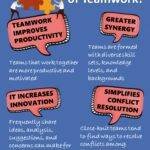
How to Create a Sustainable Culture of Teamwork
Create a sustainable culture of teamwork isn’t about one-off events or grand gestures; it’s about weaving team-building into the very fabric of your everyday work culture. This means moving beyond the annual retreat or occasional workshop and finding ways to integrate collaborative, community-building activities into the daily rhythm of work.
One effective strategy is to introduce “micro team-building” activities. These are small, low-effort interactions that don’t require significant time or resources but can significantly impact team cohesion and morale.
For example, starting meetings with a quick round of personal or professional wins allows team members to share and celebrate their achievements, fostering a culture of support and recognition. Another strategy is to implement themed team lunches or coffee breaks, either virtually or in person, depending on the working arrangement.
These should be informal gatherings, perhaps with a simple conversation starter or game, that encourage team members to connect on a personal level beyond work-related discussions.
Creating a “kudos” system, where team members can publicly acknowledge each other’s efforts and successes, is another low-effort but impactful activity. This can be facilitated through digital platforms or physical boards in the office. It’s a powerful way to make appreciation and positive reinforcement part of the team’s standard communication.
By integrating these simple yet effective activities into daily work life, teams can foster an environment of continuous improvement, collaboration, and camaraderie. This ongoing effort helps in building a resilient and cohesive team culture that can adapt to challenges and leverage opportunities more effectively.
Measuring the Impact
Determining the success of team-building activities is as crucial as the activities themselves. To measure the impact effectively, it’s important to establish Key Performance Indicators (KPIs) that align with the organization’s goals. These could range from quantitative metrics like increased productivity rates and lower employee turnover to more qualitative outcomes such as improved team cohesion and communication.
For a comprehensive evaluation, both qualitative and quantitative methods should be employed. Surveys and feedback forms can reveal insights into how team members perceive the effectiveness of the activities in enhancing collaboration and morale. On the other hand, tangible metrics like project completion rates and the number of conflicts resolved can provide objective data on productivity improvements.


